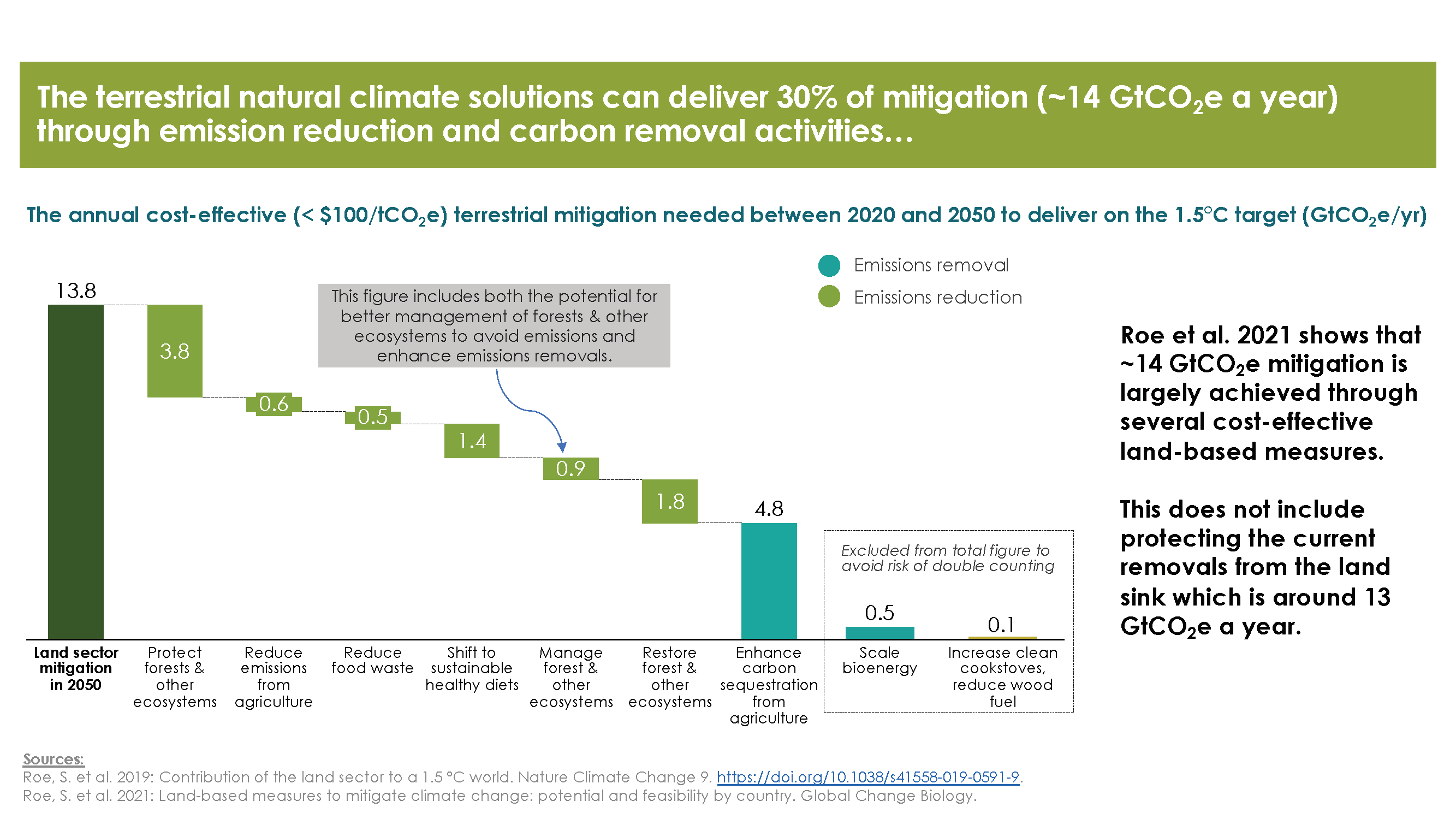There is an urgent need to identify financing strategies for nature-positive investment opportunities. These sources of finance will include, but necessarily go beyond, carbon markets which will be unlikely to deliver the scale of financing that some studies promise.
Berlin/London 4 May 2022
By Charlotte Streck; Szymon Mikolajczyk; David Landholm; Sanggeet Mithra Manirajah; Scarlett Benson; Talia Smith; Natasha Mawdsley, Abel Hemmelder, Alex Andreoli
Land – including agricultural land, forests, and other ecosystems – provides the basis of terrestrial life. It is vulnerable to climate change and, at the same time, provides essential mitigation opportunities. Forests, agriculture and our food systems offer emission reduction potentials as they emit significant amounts of greenhouse gases – carbon dioxide, methane and nitrous oxide – and offer the opportunities to sequester carbon in natural systems. Together, emissions and sequestration of land systems account for 48% of anthropogenic greenhouse gases flowing into and out of the atmosphere. Without tapping into the mitigation opportunities of the land sector, it will be impossible to meet the Paris Agreement’s temperature goals.
Despite their massive mitigation potential, land-based mitigation measures, ranging from reduced deforestation to the impacts of dietary shifts, remain chronically underfunded and receive less than 2% of global climate finance. Governments’ climate pledges to nature remain disappointingly modest, even though announcements made at the Glasgow climate conference suggest an acknowledgment that finance for forests and their indigenous stewards must be ramped up.
Governments often struggle to understand how to best mobilize investments into land-based programs. One reason for this is that they do not fully understand the rules and dynamics of private carbon markets. Private investors often lack the understanding of where and how to invest in land-based mitigation, including which concrete project and jurisdictional-level investment opportunities exist and how to structure investments in nature and sustainable landscapes. All actors lack the information needed to assess the economic opportunities provided by a sustainable, nature-and climate-positive economy
Climate Focus and the Food and Land Use Coalition (FOLU) have teamed up to fill this knowledge gap and assess how different financial instruments can be used to realize the land sector’s climate potential. While the results of the study will only be published in September of this year, it is already becoming obvious that the deployment of investments into nature-based mitigation faces many barriers and that the supply of carbon credits is likely to be much smaller than demand-side oriented studies suggest. Therefore, a more diversified set of financial instruments from both public and private investors are needed to unlock the full mitigation potential of nature-based solutions.
Nature-positive mitigation options are essential to stabilize the climate
Changes in land use, improved management of lands, improved food systems and diets can deliver significant levels of cost-effective mitigation. If designed and implemented well, the protection, restoration or management of natural and semi-natural ecosystems and the sustainable management of working lands such as cropland – or timberlands can also enhance our resilience and adaptation to climate change. Figure 1 visualizes the results of recent academic research on the cost-effective mitigation potential across 20 different categories of nature-based mitigation options, estimating that by 2050 about 14 gigatons of carbon dioxide equivalents per year can be reduced and removed, twice the total emissions from global transport, at a price below USD 100 per ton.

Investment into nature-based solutions faces multiple barriers
The UN calculates that investments in nature-based solutions will have to increase to USD $536 billion a year in 2050 to meet climate change, biodiversity and restoration targets. While this amount sounds enormous, it is not more than half a percent (0.5%) of estimated annual global GDP. Much of the required investment will have to come from the private sector, but both the policymakers and investors lack clarity on where cost-effective mitigation potentials exist, and which financial strategies are best placed to unlock this potential.
Unclear policies, unenforced regulations, weak land tenure systems, and an absence of local capacities negatively influence the investment climate of countries. When it comes to carbon markets, ecosystems and production areas covered by alternative policy instruments may not offer additional carbon market opportunities. Where emissions come from multiple and dispersed sources – as is often the case in agriculture – aggregation in programs, monitoring of emissions, and structuring of financing is challenging. In many project and program types, from Reducing Emissions from Deforestation and Forest Degradation (REDD+) to agroforestry, securing permanence is costly and requires engagement over many decades. Land conflicts, common in many countries, also hold back investments. Where the land is owned by the government, investments depend on close cooperation between public and private actors, which requires overcoming problems related to timing and mutual mistrust.
A problem that cuts through all nature-based solutions is that both governments and private entities find it difficult to identify investment opportunities. Few governments are familiar with climate finance options and investment criteria. At the same time, international investors which seek to deploy, for example carbon finance, have a hard time identifying carbon investments in forest or agricultural sectors in lower-income countries with the limited data and information available.
Investments are often country and region-specific and require a good understanding of the local context. So far, only limited actionable information for investors and policymakers exists, and there are hardly any country-specific opportunity assessments. Global studies name the problem but contribute little to solving it. To tackle the information-investment gap, it is therefore essential to move from the identification of a global need to define country and location-specific investment opportunities across all nature-based mitigation options.
The need for country-level studies
Country-level investment assessments can identify investment opportunities and facilitate decision-making by land managers, policymakers, and investors. Our study seeks to take a first step to address this data and information gap. We have developed a methodology that allows the assessment of the suitability of finance strategies in different geographic contexts. We have built a database of over 600 nature-based projects and programs in over 160 countries, with a wide diversity in terms of scale and activity type. We are analyzing the cost and revenue streams of these projects/programs to give investors – both public and private – confidence that investments in nature-based solutions will not only create positive returns for nature and society, but also for investors and shareholders.
We also looked at carbon market opportunities, combining top-down models that identify opportunities linked to carbon prices with a bottom-up analysis of existing carbon projects and programs, policies, land tenure regimes, and relevant governance indicators. A first set of case studies is conducted for Colombia and Kenya, with other countries added in the future. For example, we seek to define modalities to draw investments into Kenya’s agricultural sector and look at the opportunities for forest restoration in Colombia. We link opportunity costs for conservation with maps that identify the most appropriate land use in a country, where such maps are available, and look at land tenure and the host country willingness to embrace and support private investment.
Carbon markets provide an opportunity to channel finance into nature-based mitigation solutions
Voluntary carbon markets have been gaining growing attention as one of the most promising financing strategies for unlocking nature-based mitigation potential at scale. Mitigation estimates across nature-based solutions suggest a mitigation potential of 2.5 GtCO2eq yr-1 over the period 2020 to 2050, to 6.7 GtCO2eq yr-1 by 2030. These data have led the Taskforce on Scaling Voluntary Carbon Markets (TSCVM) to estimate USD5-50 billion in potential annual carbon investments. The large range being reported in these studies points towards huge uncertainties with regards to the likely role the voluntary carbon market can have in unlocking investments in nature across the globe. Considering these uncertainties, other investment instruments are needed to support nature-based carbon finance. While issuances from nature-based carbon projects and programs reached a record high in 2021 at 159 MtCO2e [1], over 90 percent of last year’s issuances related to pre-2020 vintages.
However, the high demand for nature-based carbon credits and increasing prices provide an opportunity. So far, demand is fast outpacing supply. This provides an opportunity to attract carbon finance to projects that would not have been possible to fund a couple of years ago. Notwithstanding the opportunity, the development of high-quality carbon projects and programs (including at the jurisdictional level) can take years, and the potential is reduced by a lack of expertise in developing projects and programs, as well as a critical knowledge gap for supporting and informing investment decisions.
But other financing instruments are needed to realize nature’s mitigation potential
Identifying and matching financing strategies to country-level investment opportunities will help to facilitate the flow of carbon finance into nature. We therefore pair the analysis of carbon market potentials with an evaluation of the effectiveness of other financial instruments – including debt, equity, grant funding and carbon finance, among others – at unlocking investments in nature-based mitigation measures. We are seeking to quantify what level of investment we can expect from land-sector companies investing in their own value chain mitigation activities as part of their decarbonization strategies. Based on this analysis, we propose investment pathways to 2050 which indicate how different financing strategies could be applied by public and private financiers over the next three decades.
Channeling finance into sustainable and nature-positive landscapes requires informed policymakers and investors. Our study develops a set of tools that enable governments to make informed decisions about how to attract finance into priority mitigation opportunities and maps investment opportunities for private investors – all with the goal of overcoming the inertia that inflicts land-based mitigation investments and to ensure that nature is empowered to contribute to climate, biodiversity and development goals.
Footnotes:
[1] Analysis based on the following leading four voluntary carbon standards: Verra’s Voluntary Carbon Standard (VCS); the Gold Standard (GS); the American Carbon Registry (ACR); and the Climate Action Reserve (CAR)


